Advanced approach of magnetic relaxation
Project Director: Dr. Victor KUNCSER
National Institute of Materials Physics
The project proposes a suite of tools and methodologies for a comprehensive characterization of the magnetic response and the magnetic relaxation process in real systems of interacting non-identical nanoparticles, to be applied in different domains (from biomedical applications to nanoelectronics and spintronics). The accomplishment of the project objectives will lead to a deeper knowledge of relaxation mechanisms in nanoparticles and to derived possibilities of controlling the relaxation process. It will be taken into consideration composition and stoichiometry, phase structure, size distribution, morphology, couplings among magnetic entities, surface effects in the attempt to correlate the mechanism of relaxation to all and every specific parameter related to nanoparticles. Theoretical and experimental approaches will be developed and permanently corroborated. A new possibility for adjusting the magnetic relaxation of nanoparticulate systems via molecular control over distances between particles and surface ligands through a new class of bio-inspired architectures is also proposed. Ways to develop self-assembly approaches for the controlled encapsulation of magnetic nanoparticles in viral protein cages are envisaged. The tuning of magnetic relaxation through inter-particle interactions or by increasing the anisotropy energy of each particle via non-spherical shapes or intra-particle interfacial couplings in core-shell configurations will be considered.
Objective I: Deep investigation via low temperature and applied field Mössbauer spectroscopy for a comprehensive characterization of the nanoparticulate systems.
Objective II: Versatile theoretical models involving mainly physical and numerical solutions, linking the temperature dependent magnetic response obtained by Mössbauer spectroscopy and magnetometry to magnetic relaxation parameters.
Objective III: Developing suitable methodologies proving the strength of the inter-particle interactions.
Objective IV: Studying the relaxation mechanisms responding for the blocking temperature in superparamagnetism and, respectively, exchange bias in case of core-shell nanoparticle systems.
Objective V: Controlling the magnetic relaxation in a new class of bio-inspired architecture for bio-medical applications.
Kuncser Victor, Filoti George, Schinteie Gabriel, Palade Petru, Dragnea Gabriel, Greculeasa (Sandu) Simona, Stanciu Anda, Catrina Andrei, Leca Aurel, Gheorghe Gheorghe, Stoica Andrei
Scientific Report 2011 (in Romanian) - download
Scientific Report 2012 (in Romanian) - download
Scientific Report 2013 (in Romanian) - download
Scientific Report 2014 (in Romanian) - download
Synthetic Report 2011-2014 - download
Scientific Report 2015 (in Romanian) - download
Scientific Report 2015 - download
Project Description - download
The work-plane assumes the existence of 5 stages. Along each stage will be accomplished parts of different objectives. The time commitment runs along the objectives. Sharing activities along the stages are:
Stage I: Complex investigations, including low temperature and applied field MS of spinel-like nanopowders
Stage II: Complex investigations, including temperature/field dependent MS and magnetometry, of nanoparticles for bio-medical applications. VNPs are also envisaged. Modeling magnetic relaxation for MS and magnetometry.
Stage III: Studying interparticle interactions. Comparative study of relaxation phenomena in SPM and exchange bias effects on core-shell nanoparticles
Stage IV: Modeling and parameter-setting of interphase and interparticle interaction
Stage V: The control of relaxation phenomena in nanoparticle systems for biomedical applications
Some results:
- Studying magnetism of Fe-oxide nanoparticles obtained by Laser pyrolysis (e.g. spin configurations in Fe-oxide nanoparticles with spinel structure. Evidence for the antiferromagnetic coupling and spin disorder degree by in field Mossbauer measurements and evidence of increased crystallization via hydrogenation treatment:

- Studying magnetic relaxation and phase composition in Fe carbide composites obtained by laser pyrolysis:
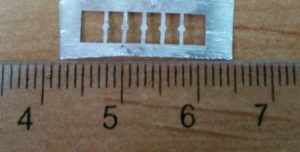
- A new methodology based on corroborating energy dispersive spectroscopy, magnetometry and temperature dependent Mossbauer spectroscopy data was elaborated in order to distinguish between nanoparticles of core-shell structure or a mixture of different mono-phase nanoparticles. In the range of a few nm average size, neither HRTM is able to provide such complex information:

Sample | KVFe-C (10-20J) | KVFe-bcc (10-20J) | DFe-C (nm) | DFe-bcc (nm) |
| S1 | 1.28 | 5.75 | 8.00 | 13.20 |
| S2 | 1.46 | 10.90 | 8.35 | 16.33 |
Fig.4.Temperature dependent Mossbauer spectra of other two different samples obtained by laser pyrolysis (see table on top for preparation conditions) and related procedures based on magnetic relaxation phenomena followed by Mossbauer spectroscopy, to determine phase composition, average size and anisotropy energy of each type of nanoparticle in the composite samples
- Studying magnetic relaxation in naked (MPs) and dopamine surfacted magnetite (MF-MPs) nanoparticles for biomedical applications. Elaboration of a new procedure for estimation of the magnetic size dispersion:
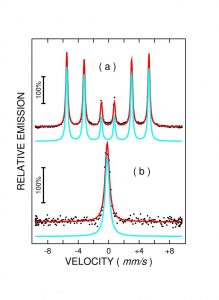

- Studying magnetic relaxation phenomena and interparticle interactions in ferrofluids.
·
- The analytic expression of the relaxation phenomena for a system of identical independent nanoparticles and its critical examination with respect to the initial conditions. Demonstration of M(t) sensitivity on both material parameters and initial conditions. Obtaining the temperature dependences of the magnetization in different time intervals:

Fig 8: The relative magnetization dependence on temperature, corresponding to 3 different time measuring intervals, shown in the figure legend. Simulation conditions: M0/MS =0, τ0=10-8s, KV=700k, Δ=0.001KV.
- Study of the magnetic relaxation phenomena in real systems, taking into account dimension distributions and inter-particle interactions.
The nature of the interactions appearing in nanoparticle systems is directly related to the mean mutual distance between particles (in this way, it is dependent on the NPs concentration) and to the NPs possibility to be or not in contact or to involve a direct or indirect electron exchange (depending on the medium type in which these are dispersed).
If the particles are in direct contact, the most probable interactions are the exchange interactions implying the magnetic atoms electrons situated on the particle surface or the exchange interactions mediated by the atoms of the nonmagnetic matrix in which the nanoparticles are immersed. Alternatively, if the nanoparticles are immersed in a metallic matrix, interactions mediated by conduction electrons can occur (Ruderman–Kittel–Kasuya–Yosida–RKKY-type interactions). Except these electron mediated interactions, which manifest on very short distances, in a nanoparticle system long range magnetic interactions, called dipolar magnetic interactions, occur.
Regarding the medical applications, the magnetic nanoparticles are functionalized by covering them with an organic surfactant (polymeric layer), which besides a specific functional role, it is able to prevent the physical contact between particles, their aggregation and sedimentation. Even in these special conditions, under a certain temperature, dipolar magnetic interactions can appear, especially when the NPs concentration is not negligible. From this point of view, the discussion continues supposing interparticle interactions with increasing intensity. Further, it is supposed that nanoparticle interactions may lead on a hand to the modification of the system energy (and implicitly of the potential barrier ) and on the other hand to the modification of the magnetic phase transitions (and implicitly of certain characteristic temperatures). These two parameters of interest could be determined experimentally if both the implicit relaxation time and the temperature at which the relaxation time equals the measuring time interval would be known. Consequently, different interaction regimes would imply several relaxation time expressions, as a function of energetic parameters and magnetic transitions.
For small volume ratios, η , the distribution of monodomain particles in a ferrofluid keeps the independent SPM character of each particle. Increasing the concentration, the mutual dipolar interactions will grow in intensity and the characteristic relaxation time will depend on the presence of the other particles in the system, a collective magnetic behavior being assigned to the system (the system which phases from a superparamagnetic phase to an independent particles type phase implies the so called modified SPM, unlike the system which passes from the SPM state in a collective magnetic state).
Various approaches regarding the states generated by the magnetic interactions, from the modified superparamagnetism to superspin-glass (SSG) states or superferromagnetism (SFM) can be found in references [1,2, 5-7]. In accordance with these results, the magnetic relaxation process, described by the Neel-Brown relation, undergoes different modifications depending on the mutual magnetic interactions intensity:
(i)in the case of sufficiently weak dipolar interactions, only the anisotropy energy barrier modifies (3)
(3)
(ii) increasing the intensity of magnetic interactions (small interparticle distances), supposing a disordered magnetic spins orientation, a real transition from the SPM state in the SSG state under a certain transition temperature (Tg )

(4)
where is a critic exponent. In these expression the form of the magnetic relaxation law is modified, the characteristic time constant having a distinct signification.
(iii) Finally, at very high nanoparticle concentrations, the magnetic interactions can create special conditions for a similar behavior with the ferromagnetic one in which the spatial arrangement of the magnetic spins is produced under a critical transition temperature (Tc) ;
In the present studies only the cases with medical significance were addressed, cases which resume in general to the modified SPM situation, the relaxation time being described by the equation (3). It is to be mentioned the existence of two magnetic relaxation regimes, namely:
(i) collective oscillation regime (which appears when the heating energy is considerably lower than the width of the barrier introduced by the anisotropy energy KV of the NP) and
(ii) the superparamagnetic relaxation regime (which occurs at thermal activation energy comparable to the width of the KV barrier), respectively.
The arguments and methodologies developed by both relaxation regimes were applied in various situations.
- The discussion of the non-identical particles case and the problem solving possibilities for obtaining the volume distributions probabilities via magnetometric measurements and Mossbauer spectroscopy, respectively.
A first exemplification refers to the establishment of the dimension distribution of magnetite nanoparticles from two types of paleosols (one specific to the Mircea Voda region and the other specific to Costinesti region), collected from various depths, corresponding to various interglacial periods. The Mossbauer spectra obtained at different temperatures for these two samples (MV indicative for Mircea Voda and C indicative for Costinesti ) are presented in Fig. 9.
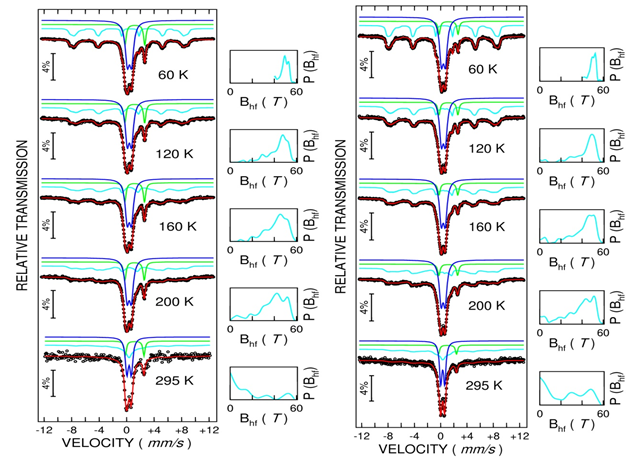
Fig.9. Mossbauer spectra dependent on temperature, coresponding to S3 MV sample (left) and S3 C sample (right), respectively
In all analyzed samples the presence of two paramagnetic spectral components (assigned to Fe ions dispersed in silicate matrix) and two magnetic components, their relative weight depending on sample, is emphasized at low temperatures (5K, inclusively).The investigation of magnetic relaxation on each magnetic phase (magnetite and haematite) can be done based on Mossbauer methodology corresponding to collective excitations regime.The mean hyperfine magnetic field distribution and the field distribution width (in the magnetite NPs case) are shown below, for each one of the samples:
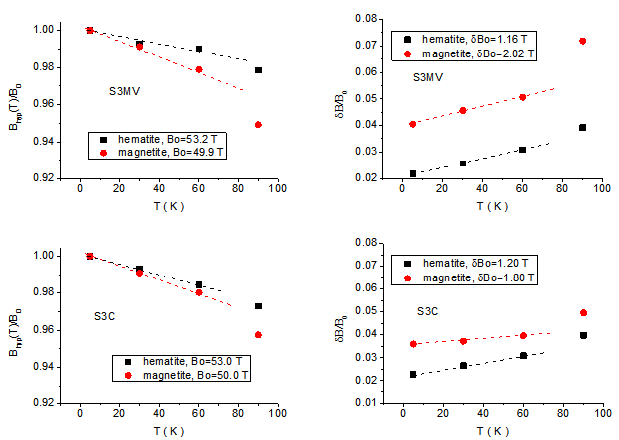
Fig.10. The temperature dependence of the hyperfine magnetic field and of the distribution width of the hyperfine field (proportional to the spectral line width), both relative to the hyperfine field in static regime.
The width of the potential barrier and the relative dispersion of the potential barrier (the relative dimension dispersion of the nanoparticles, considered spheres of diameter D), respectively are presented in the tables below, for each type of NP:

In order to use the more accurate dimensions/volumes terminology, the involved anisotropy constants have to be determined, which could be achieved in general via magnetometry measurements (hystreresis cycle) in static regime.
The dependence of coercive fields on T1/2 for four of the analyzed samples (S2MV, S3MV, S2C and S3C)is illustrated below. One observes a linear decrease of the coercive field as a function of T1/2 for temperatures above 25 K. Supposing that this decrease is strictly related to the thermal activation processes over the one-particle potential barrier ( the anisotropy constant and the material specific constant being constant with the temperature), the temperature dependence of the coercivity is given by the equation Hc=Hc0(1-T1/2/TB1/2) with Hc0 expressed with the ratio K/Ms* (Ms* is the spontaneous magnetization).

Fig.11. The coercive field dependence on T1/2 for four of the analyzed samples
Finally, the anisotropy constant is obtained and further, using the slopes SL1 and SL2 from Fig 10 (only dependences corresponding to magnetite), the mean dimension and the relative dispersion of the samples S3MV and S3C, Mossbauer investigated, can be obtained:

It is to be mentioned that the dimension distribution of the magnetite nanoparticles can be also earned using a methodology based on magnetic susceptibility measurements in a.c. as a function of frequency (called frequency spectrum magnetic susceptibility –FSMS). It can be demonstrated that the so derived distribution overestimates the real dimensions of the nanoparticles. For example, the nanoparticles mean dimension derived from FSMS is 20% higher than the dimension derived from Mossbauer spectroscopy (see table above), pointing therefore the limits induced by the magnetometry method.
- Description and critical discussion of analysis and characterization methodologies of long range particle interactions (dipolar interactions and interactions transmitted through substrate, respectively).
· Exemplification of methods for obtaining the information related to the NPs interactions can be done for a magnetic ferro-fluid set, with distinct volume ratios (the volume ratio η being defined as the ratio between the volume associated to the solid part and the volume of the ferro-fluid; similarly, the ferro-fluid density can be evaluated based on the relation ρFF = ρNPs η + ρTO (1- η) ) given in the table below:

The Mossbauer spectra dependent on temperature for the FF1 sample are illustrated in Fig. 12, where the evolution of the mean hyperfine field with the temperature can be seen also for all the three studied samples. One observes a much slower decrease of the high density (high volume ratio) ferrofluid samples with the temperature, which is equivalent to higher energetic barriers for these samples.
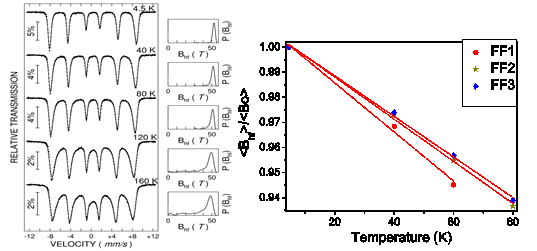
Fig.12. Mossbauer spectra in the collective excitations domain for the FF1 sample (left) and the temperature dependence of the reduced mean hyperfine magnetic field, for all 3 analyzed samples, respectively.
As the only difference between the samples is the volume ratio, the values obtained for the anisotropic energies using relation (8) and the experimental slopes SL1 from Fig.11 increase with the volume ratio from the 480 K value in FF1 to the 570 K value in FF3.
- Developing specific methodologies for studying specific absorption rates of NPs with respect to magnetic hyperthermia and possibilities for optimization of NP systems for such applications.
In order to prove how one can obtain information about mean energy transfer efficiency in a nanoparticle system (magnetic hyperthermia), magnetite-based ferrofluids characterized above were considered. The volume fraction varied in the range 0.005-0.16. To be noted that in the case of superparamagnetic NP, the power transfered from the alternating magnetic field per unit volume of ferrofluid, proportional to the dephased susceptibility component, was mathematically described by Rosenweig:
![]()
![]()
where ![]() is the effective relaxation time, taking into account both the Brownian relaxation mechanism as well as the Neel mechanism with
is the effective relaxation time, taking into account both the Brownian relaxation mechanism as well as the Neel mechanism with ![]() and
and ![]() relaxation times, f and H0 are the frequency and the amplitude of the AC magnetic field,
relaxation times, f and H0 are the frequency and the amplitude of the AC magnetic field,![]() is the air permitivity and is the equilibrium susceptibility. The specific absorption rate (SAR) is defined as:
is the air permitivity and is the equilibrium susceptibility. The specific absorption rate (SAR) is defined as:
![]()
![]() where qp(T) is the the power per unit volume, m is the ferrofluid mass,
where qp(T) is the the power per unit volume, m is the ferrofluid mass, ![]() ,is the specific heat,
,is the specific heat, ![]() is the rate of temperature increase, estimated in adiabatic conditions. As a result, SAR can be easily determined by experiment if the rate of temperature increase in the ferrofluid of interest was determined. This can be obtained using an experimental device presented in Fig. 13 (purchased within this project).
is the rate of temperature increase, estimated in adiabatic conditions. As a result, SAR can be easily determined by experiment if the rate of temperature increase in the ferrofluid of interest was determined. This can be obtained using an experimental device presented in Fig. 13 (purchased within this project).
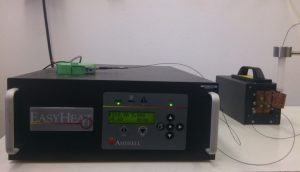
Fig. 13. Experimental device for SAR determination, consisting of an RF generator, a heating coil in which the sample room is inserted and a system used to determine the temperature increase in time.
In this respect, 2 experimental methodolgies were developed for compensation of heat loss in the evaluation process of the specific absorption rate for ferrofluids under radiofrequency magnetic excitaion in thermal non-equilibrium conditions. Both of them allow the experimental determination of the disipated power in a finite temperature interval. Thus, the ferrofluid sample is subjected either to alternative heating and cooling processes corresponding to small temperature intervals (the first methodology) or to an unique heating process followed by a cooling in an identical temperature interval (the second methodology). The basic ideea is to associate to each temperature point in the experimental interval considered for data aquisiton (T(t)), a heating speed (vh(T) ) and a cooling speed (vc(T)). The absolute value of cumulated vh(T) and vc(T) would result in a so-called adiabatic heating speed va(T) corresponding to the heating process in the absence of losses. Based on va(T) values, the temperature adiabatic curve T(t) associated to the magnetic excitation of the ferrofluid sample. SAR, as a function of temperature, can be determined using the relation (**). The power P can be determined further as it is theoretically described by the relation (*). Finally, the fitting of the experimental dependence P(T) with the theoretical expression (*) can be implemented (if the material parameteres are determined by complementary investigation methods) in order to study the effects of interparticle interactions on thermal transfer phenomena.
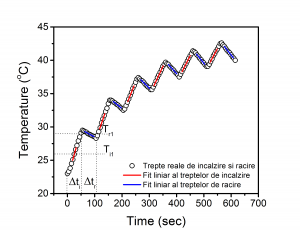

Figure 14. Registration of heating and cooling information corresponding to the different methodologies described above.
In order to analyze the influence of the volume ratio on the SPM response of a ferrofluid, four samples - belonging to a completely characterized ferrofluid from structural and magnetic point of view - with volume ratios in the interval (0.005-0.16) were used. In a first stage, the adiabating heating curves of these samples have been determined as a response to the excitation with a radiofrequency magnetic field of variable intensity in the domain (14-35 kA/m). An RF (235 kHz) inductor with uniform magnetic field in interior was utilized. Temperature monitoring of each ferrofluid sample was realized by means of a fiber optic thermometer connected to a computer. The ferrofluid samples with a volume of 2 ml were introduced in a PVC evacuated tube, centered in the radiofrequency inductor. After the application of the first methodology, for the sample having the highest volume ratio ![]() exposed to a magnetic field intensity of H01=14 kA/m, the adiabatic curve plotted with red circles in Figure 15 (compared to the experimental heating curve plotted with black circles) was obtained.
exposed to a magnetic field intensity of H01=14 kA/m, the adiabatic curve plotted with red circles in Figure 15 (compared to the experimental heating curve plotted with black circles) was obtained.
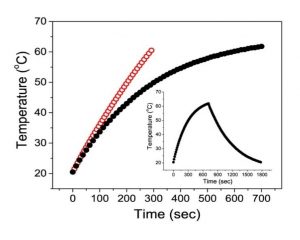
Fig. 15. The adiabatic heating curve (red symbol) and the experiemental heating curve (black symbol). Inset shows the experimental heating and cooling curves that provide the 2 heating/cooling rates used by the methodology proposed for obtaining the heating curve in adiabatic conditions.
The intrinsic ferrofluid parameters, determined by interpolation/extrapolation of experimental values obtained above in known working conditions ( f, H01), were used to fit the adiabatic curve described by the relation (*). The product dependence on the volume ratio is illustrated in Figure 16 (left), whereas the specific heat dependence on temperature is exemplified in the case of the most diluted sample in Figure 15 (right).

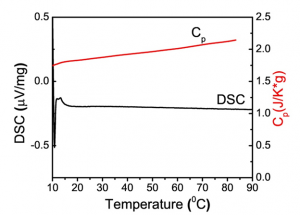
Fig. 16. Experimental dependencies of the anisotropic energy as a function of volume ratio and of the specific heat as a function of temperature, respectively
Examples of adiabatic curves derived from experiment and their best fits are presented in Fig. 17 for 2 different volume ratios. It is observed that for higher volume ratios, a good fitt is obtained in a quite low temperature range. Taking into account that SAR can be determined with the best precision by considering the initial slope (linear increasing zone) of the T(t) curve, the optimal fitting parameters can be searched (others than those obtained by complementary methods and those imposed on the alternating field). It is observed an unexpected variation of the time constant, as unique variable parameter, with the volume ratio.
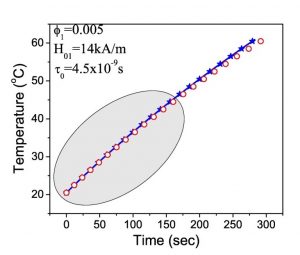
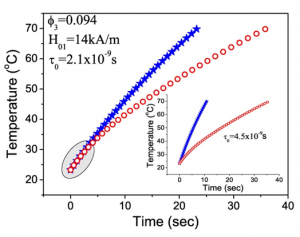
Fig. 17. T(t) experimental (red symbol) and theoretical (blue symbol) dependencies, for 2 distinct volume ratios (0.005 – left and 0.094 – right). The inset of the right figure (higher volume ratio) shows the 2 dependencies, for a constant ![]() equal to that specific to the case of the smaller volume ratio.
equal to that specific to the case of the smaller volume ratio.
The conclusion, confirmed by theoretical computations (in process of publication), is that the time constant, , considered usually as a material constant, is actually a system constant and it is dependent on the interaction between components (it is quasi-exponential decreasing with the intensity of the interactions among particles). This behavior leads to a decrease of the SAR - per mass unit of nanoparticles - with increasing volumic density of the particles which directly influences the local hyperthermia process associated to different nanoparticles densities on the tisue of interest.
- Magnetic phenomena associated to nanoparticles presenting catalytic properties (Ru) and/or photocatalytic (TiO2), that can be magnetically actioned either by means of magnetic shell (the case of Ru nanoparticles coated in a magnetite shell), or by diluted magnetism effects or by magnetic clusters formation on their surface by Fe dopping
To be mentioned the study of Fe-doped TiO2 nanoparticles in sufficiently small quantities such that the magnetic effect could be predominantly related to diluted magnetism. The hysteresis curves (measured on SQUID) at different temperatures for a sample consisting of TiO2 nanoparticles doped with 1% at. Fe (S2) are presented in Figure 18 (a). The raw curves are shown in the inset of Figure 18 (a), whereas the main graph contains only the loops attributed to the dilutted ferromagnetic contribution. It is observed that the last one presents a finite coercivity, in the domain 40-70 Oe at temperatres higher than the room temperature (this dilutted ferromagnetism is associated to different types of oxygen defects in the TiO2 matrix). The dependence of the coercive field on temperature, as related to the defects ratio in TiO2, evaluated by the double integral of the intensity of the spectral line in RES, is depicted in Figure 18 (c) (it was considered the case of the previous sample after a treatment in oxygen). Figure 18 (b) presents the magnetization curves on cooling for different samples (treated_T and untreated, with doping concentrations of 0 % at. _S0, 0.1% at._S1 and 1% at._S2). One can remark the superposition of 2 regimes, namely: the diluted ferromagnetism (prevailing at temperatures higher than 200 K) and the paramagnetic/superparamagnetic regime due to the dissolved Fe and Fe clusters, respectively ( it is shown that they are formed as Fe oxides having a very small number of Fe atoms antiferromagnetic coupled) that contribute insignificantly to the sample magnetization.
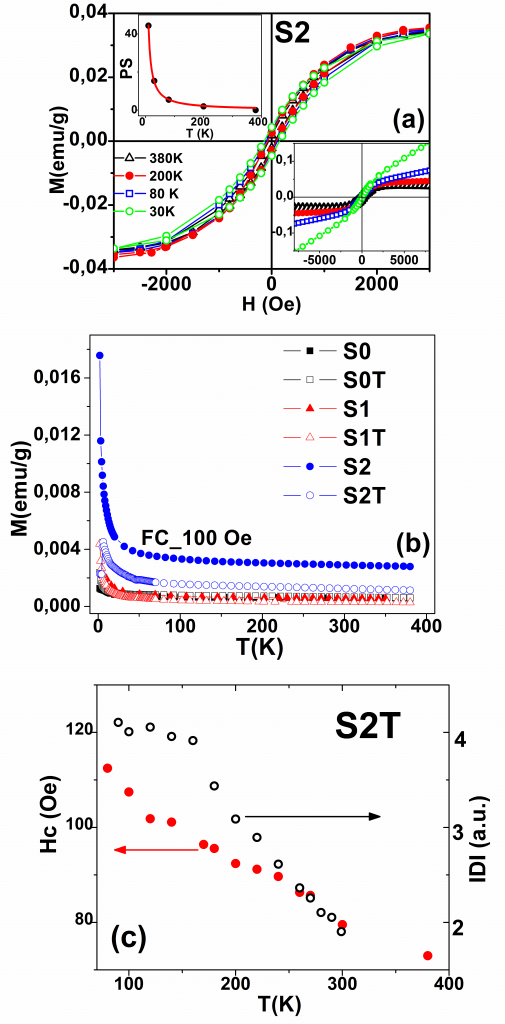
Figure 18.(a). Hysteresis loops at different temperatures for S2 sample (the main graph depicts the loops specific to the diluted magnetic phase, down right inset – raw curves,top left inset - dependence of paramagnetic susceptibility on temperature) (b) The dependence of FC curves mesured in 100 Oe for the undoped samples (S0 and S0T) and the doped samples with 0,1 % at. Fe (S1 and S1T) and 1 % at. Fe (S2 and S2T) (c) Temperature dependence of the coercive field and of the double integrated intensity from RES, proportional to defects fractio in TiO2.
In order to corelate the magnetic data with the local configuration of Fe ions, temperature dependent Mössbauer measurements were realized. The two spectral components evidenced even at 5 K were attributed as follows: the central doublet to paramagnetic Fe3+ ions in high spin configuration (S=5/2); the broad sextet with a hyperfine magnetic field of aproxiately 51.8 T to a oxidic Fe structure, which due to a collapsing effect at room temperature it should corespond to extremly small Fe oxide clusters. In accordance with this result obtained by Mössbauer spectroscopy, Fe ions in the sample cannot contribute to the diluted magnetism (inclusively evidenced at the room temperature), but only to the sample paramagnetism/superparamagnetism. Indirectly, the dopants may induce additional defects in TiO2 nanoparticles and consequently may increase the diluted magnetism associated to them [10].
Additional non-detailed studies have been considered:
- Analytical expression of the relaxation curve for independent and identical nanoparticles and critical discussion with respect to initial conditions and material parameters.
- Discussions on susceptibility components with emphasis on provided information (blocking temperature-by the in phase component and dissipated power by out of phase component) and theirs connections to magnetic hyperthermia applications.
- Description and critical discussion of methodologies providing evidence of inter- and intra-particle interactions
- Making difference between local magnetism due to magnetic nanoclusters and long range magnetic order in diluted magnetic oxides
- Studying the intrinsic magnetic properties of half metallic magnetic materials by DFT calculations
- Local electronic phenomena and atomic configuration in perovskite based nanoparticles with catalytic applications
- Magnetic anisotropy and peculiar spin configuration in metallic nanowires grown by the template method
- Superparamagnetic relaxation in magnetite-polymer nanocomposites
Publications:
[1] Superparamagnetic magnetite-divinylbenzene-maleic anhydride copolymer nanocomposites obtained by dispersion polymerization; D.Donescu, V.Raditoiu, C.I.Spataru, R.Somoghi, M.Ghiurea, C.Radovici, R.C.Firescu, G.Schinteie, A.Leca, V.Kuncser, European Polymer Journal 48 (2012) 1709-1716
[2] Half-metallic state and magnetic properties versus the lattice constant in Ti2CoSn Heusler compound: An ab initio study; A.Birsan, P.Palade, V.Kuncser, Solid State Communications 152 (2012) 2147-2150
[3] Magnetic properties of iron-carbon nanocomposites obtianed by laser pyrolysis in specific configurations; G.Schinteie, V.Kuncser, P.Palade, F.Dumitrache, R.Alexandru, I.Morjan and G.Filoti, Journal of Alloys and Compounds 564 (2013) 27-34
[4] Iron Oxide Magnetic Nanoparticles with versatile surface functions based on dopamine anchors; M. Mazur, A. Barras, V. Kuncser, A. Galatanu, V. Zaitzev, P. Woisel, J. Lyskawa, W. Laure, A. Siriwardena, R. Boukherroub and S. Szunerits, Nanoscale, 5 (2013) 2692-2702
[5] Microstructure related magnetic properties in Co implanted ZnO thin films; L.C.Nistor, C.Ghica, V.Kuncser, D.Pantelica, J.J. Grob and M.Dinescu, J.Phys.D: Applied Physics, 46 (2013) 065003 (10pp)
[6] Magnetic nanophases: from exchange coupled multilayers to nanopowders and nanocomposites; V.Kuncser, O.Crisan, G.Schinteie, F.Tolea, P.Palade, M.Valeanu, G.Filoti, (book chapter) in Modern Trends in Nanoscience, M.Balasoiu and G.M. Arzumanyan eds., Ed. Academiei Romane, Bucuresti, 2013
[7] Spectroscopic Investigation of Iron Substitution in EuCoO3 : Related Impact on the Catalytic Properties in the High Temperature N2O Decomposition; Wu, Yihao; Dujardin, Christophe; Granger, Pascal; Tiseanu, Carmen; Sandu, Simona; Kuncser, V.;Parvulescu, Vasile, J.Phys.Chem: C. 117 (2013) 13989-13999
[8] Magnetic configurations of Ni-Cu alloy nanowires obtained by the template method; E. Matei, Ionut Enculescu, M.E. Toimil-Molares, A. Leca and V.Kuncser, accepted at J. Nanoparticle Research
[9] Volume fraction dependent magnetic behaviour of ferrofluids for rotating seal applications;
G Schinteie, P Palade, L Vekas , N Iacob , C Bartha and V Kuncser, accepted at J.Phys.D: Applied Physics
[10] Engineering magnetic properties of nanoparticles via size effects and interphase interactions, V. Kuncser, P. Palade, A. Kuncser, S. Greculeasa, G. Schinteie, (book chapter) in “Size effects in nanostructures:Basics and Applications, V.Kuncser and L.Miu eds., Springer-Verlag Berlin Heidelberg 2014
[11] Ferromagnetic behavior of bismuth germinate oxides glass-ceramic materials, S.Polosan, R.Negrea, I.C.Ciobotaru, G.Schinteie, V.Kuncser, J. Alloys and Comp. accepted, (2014)
[12] Insulin loaded magnetic nanoparticle-graphene oxide composites:synthesis, characterization and application for in vivo delivery of insulin, K.Turcheniuk, M.Khanal, A.Motorina, P.Subramanian, A.Barras, V.Zeitsev, V.Kuncser, A.Leca, A.Martoriati, K.Cailliau, J-F.Bodart, R.Boukherroub and S. Szunerits, RSC Advances, 4, 865 (2014)
[13] Approach for an improved experimental evaluation of the specific absorption rate in magnetic fluid hyperthermia, N.Iacob, G. Schinteie, P.Palade and V. Kuncser, submitted to Journal of Nanoparticle Research (2014)
[14] Reconstruction of superparamagnetic particle grain size distribution from Romanian loess using frequency dependent magnetic susceptibility and temperature dependent Mossbauer spectroscopy, Necula, C., Pamaiotu, C.,.Schinteie, G., Palade, P., .Kuncser, V., Global and Planetary Change 131 (2015) 89-103
[15] Magnetic nanocomposites for an efficient valorization of biomass, Kuncser , V., Coman, S., Kemnitz, E, Parvulescu, V., J. Appl.Phys. 117(17) (2015) 17D724
[16] Aggregates of Mn2+ Ions in Mesoporous Self-Assembled Cubic ZnS:Mn Quantum Dots: Composition, Localization, Structure, and Magnetic Properties, S.Nistor, M.Stefan, L.C.Nistor, V. Kuncser, D.ghica, I.D.Vlaicu, Journal of Physical Chemistry C 120(26) (2013) 14454-14466
[17] Effects of magnetic dipolar interactions on the specific time constant in superparamagnetic nanoparticle systems, N.Iacob, G.Schinteie, C. Barha, P. Palade, L.Vekas, V. Kuncser, Journal of Physics D-Applied Physics 49(29) (2016) 295001-295009
[18] Stepped heating procedure for experimental SAR evaluation of ferrofluids, N.Iacob, G.Schinteie, P. Palade, C.M. Ticos, V. Kuncser The European Physical Journal E 38(6) (2015) 57.
[19] On the role of Fe ions on magnetic properties of doped TiO2 nanoparticles, F.Tolea, N.Grecu, S. Constantinescu, D. Ghica, Applied Physics Letters 106(14) (2015) 142404.
[20] A general perspective on the magnetization reversal in cylindrical soft magnetic nanowires with dominant shape anisotropy, A.Kuncser, S.Antohe, V. Kuncser, Journal of Magnetism and Magnetic Materials 423 (20170 34-38.
Presentations at international conferences/seminars:
- Mossbauer Spectroscopy –a powerful tool for investigation of local electronic phenomena and interactions in nanomaterials; V. Kuncser, invited lecture at national Physical Laboratory, London, 2012
- Complex carcterization of magnetic configurations in multiphase nanoparticulate systems; V.Kuncser, G.Schinteie, G.Filoti, A.Birsan, R.Alexandrescu, I.Morjan; oral presentation at SIWAN5-5th Szeged International Workshop on Advances in Nonoscience, 2012
- Perovskite based catalysts studied by Mossbauer spectroscopy and magnetic measurements, V.Kuncser, oral presentation at the International Symposium of the Romanian Catalysis Society, Cluj-Napoca, 2013
- Distribution of potential barriers via temperature dependent 57Fe Mossbauer spectroscopy, V.Kuncser, G.Schinteie, P.Palade and G. Filoti, accepted as oral presentation at the International Conference on the Mossbauer Effect, Croatia, 2013
- Magnetic relaxation of nanoparticulate systems in relation to bi-medical applications, V.Kuncser, N.Iacob, G.Schinteie, P.Palade, A.Leca and G. Filoti, Fifth Seeheim Conference on Magnetism, Octombrie 2013.
- Specific magnetic response of functionalized Fe oxide nanoparticles in relation to bio-medical applications, V.Kuncser, N. Iacob, G.Schinteie, P.Palade, A.Birsdan, A.Kuncser, C.Ghica, A.Leca, S.Suneritz, invited lecture at 4th International Conference on Superconductivity and Magnetism, Turkey, 2014
- Magnetic nanostructures and bio-medical applications, V. Kuncser, N. Iacob and G. Schinteie, Advanced workshop in solar energy conversion and nanophysics, Magurele-Bucharest, 2014
- MAGNETIC NANOPARTICLES FOR BIO - MEDICAL APPLICATIONS, prezentare orala la The 15th International Balkan Workshop on Applied Physics, Constanta, Romania, 2015
- Fe oxide nanoparticles in relation to magnetic hyperthermia effects, 2-nd Mediteeranean Conference on Applications of the Mossbauer Effect, Dubrovnick, Croatia, 2016 (V. Kuncser, invitet lecture)
- Layered nanostructures, nanoparticles and nanocomposites, invited lecture at Vinca Institute of Nuclear Physics, Belgrad, Serbia (2016)
- National conferences: Specific aspects of magnetic relaxation in nanoparticulate systems, V.Kuncser, oral presentation at Bucharest University Faculty of Physics 2013 Meeting
Doctoral Thesis:
[1] Iacob Nicusor:
SISTEME DE NANOPARTICULE CU POTENTIAL DE UTILIZARE IN HIPERTERMIA MAGNETICA, 2015
[2] Sandu (Greculeasa) Siomona-Gabriela
FAZE MAGNETICE SI CUPLAJE INTERFACIALE IN STRUCTURI BIDIMENSIONALE HETEROGENE, 2015.
Expected results
1. Elaboration of models of magnetic relaxation phenomenon depending on the initial setting conditions of the magnetic system in the fundamental state, and on the morphologic and magnetic parameters of the nanoparticles.
2. Determination of the time dependence of magnetization for different temperatures, in the frame of some simplified two-state models.
3. Development of methodologies for experimental determination of the parameters involved in previous models such as: determination of the mean nanoparticle diameter and of the size distribution by means of Mossbauer spectroscopy and magnetic measurements, precise determination of the time constant from Neel law, determination of the anisotropy constant and anisotropy energy by corroboration of Mossbauer spectroscopy and magnetic measurements.
4. Study of the influence of the nanoparticle interactions on the magnetic relaxation phenomenon and elaboration of methodologies specific to the experimental studies on this type of interactions.
5. Determination of the inter- and intra-particle interactions effect.
6. Determination of analysis methodologies of the nanoparticle system in magnetic hyperthermia (correct determination of the specific absorption rate).
7. Development of experimental arrangements and identification of efficient nanoparticle systems concerning the magnetic hyperthermia system.
Dr. Victor Kuncser
PROJECTS/ NATIONAL PROJECTS
Copyright © 2025 National Institute of Materials Physics. All Rights Reserved